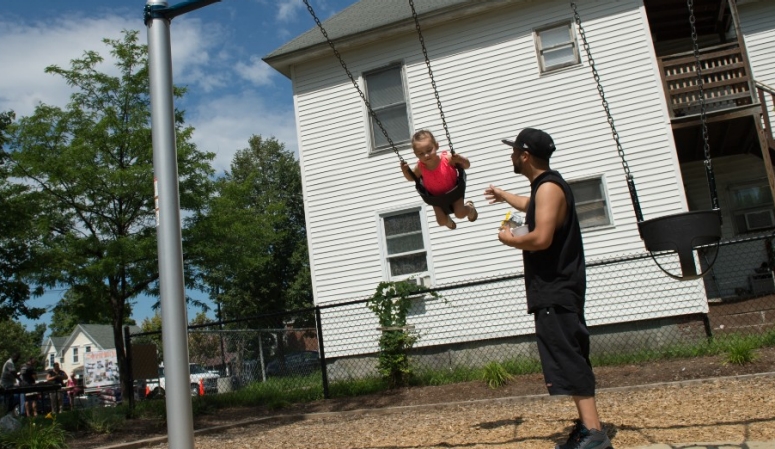Amy Gillman of the Robert Wood Johnson Foundation
A safe, secure home is where health begins. To build more equitable, healthier communities, we need to boost people’s ability to afford a good place to live.
A roof over our heads. Shelter from the storm. A beautiful day in the neighborhood. Home is where the heart is.
None of these phrases directly talks about health. But in our common language, we clearly recognize the centrality to our well-being and our happiness of the homes and neighborhoods in which we live.
In fact, there is a strong and growing evidence base linking our homes to our health. Where we can afford to live impacts where we live—and our neighborhood’s location can make it easier or harder to get a quality education and earn living wages, to afford to eat nutritious food, and to enjoy active lifestyles. And when we’re spending too much of our income on rent or a mortgage, that leaves little to pay for transportation to work or the doctor or to put healthy food on the table for our kids.
No one in America should have less of a chance to be healthy or to live in a safe, secure, affordable home because of how much money they make, where they live, or the color of their skin.
This year’s County Health Rankings show us we still have work to do to reach that goal. More than one in 10 U.S. households spends more than half of what they earn on rent or mortgage payments, according to the 2019 Rankings. And the Rankings show stark differences across and within counties in whether residents can live in affordable homes, especially for those with low incomes and people of color.
Housing Burden
As housing expenses have outpaced local incomes, many families experience the burden of severe housing cost—meaning they pay more than half their income on housing. The 2019 Rankings find:
- Renters are more likely to be severely cost-burdened than homeowners.
- For low-income renters, the burden is particularly harsh. With less income to draw on, at least 1 in 2 pays more than 50 percent of their paychecks on rent.
- Severe housing cost burden also disproportionately impacts blacks, who are more likely to rent than own.
Severe housing costs are associated with deep health and social costs for communities, according to the 2019 Rankings. Across counties, as the share of households experiencing the burden of severe housing costs increases, there are more children in poverty, more people who don’t know where their next meal will come from, and more people in poor health.
Policy and Practice Solutions
Housing policy, including discriminatory practices such as redlining, has historically influenced place-based inequities. Today, equitable housing policy and practice can be powerful tools for giving everyone a fair shot at a safe, secure, affordable place to live that promotes their health and well-being. We must keep in mind, however, that there is no single solution to high housing costs. Every community must look at the challenges in their neighborhoods and address the most pressing needs. Some places to start include:
- Building and preserving affordable homes and strengthening neighborhoods in ways that engage community members in local decision-making and avoid displacement of longtime residents.
- Connecting families to resources for affordable housing, like vouchers for low-income households.
- Increasing housing stability and reducing the risk of homelessness by ensuring basic needs are met and improving access to social services.
- Enforcing fair housing laws.
We’ve seen such approaches work in places like the 24:1 Community in North St. Louis County, Missouri. The community came together across sectors to make affordable housing a priority. Chris Krehmeyer, president and CEO of the neighborhood development group Beyond Housing, estimated that the 24:1 Community lost six or seven percent of its 15,000 households during the 2008 foreclosure crisis and had not rebounded since then. In a place where more than nine in 10 of public-school students qualified for free or reduced-price lunch and the unemployment rate was three times the county norm, a lack of affordable housing was a major issue. The majority of residents were renters, subject to a lack of stability and risk of homelessness when faced with high rents and low incomes.
Owning a home is an important vehicle for families to build wealth for their children and grandchildren, but we know from the Rankings data that not everyone has had a fair chance to pursue this valued American dream. The nationwide rate of homeownership for white families is 20 to 30 percent higher than the rate for families of color.
So the 24:1 Community sought to make affordable home ownership possible, and build wealth to create stability and opportunity across generations. In their innovative, comprehensive approach, residents own their homes, but lease the land, which is owned by a nonprofit land trust. The houses stay affordable because the trust controls the price owners receive when they sell. Buyers receive financial and homeownership counseling before they buy and supportive services after they sign the contract. There are early signs of success with increased stability for 98 percent of Beyond Housing families with school-aged children. And since the initiative launched, youth obesity has declined in the community, and the child poverty rate has come down significantly.
The Rankings release provides a timely opportunity for every community to have its own conversations and come to the solutions that will work best there. If you’d like to learn more about policies your community could implement, resources abound, such as Local Housing Solutions from the NYU Furman Center and What Works for Health from County Health Rankings and Roadmaps.
Many sectors—private developers, health systems, philanthropy, advocacy and citizen organizations, and local governments—will need to work together on comprehensive approaches to make safe, secure and affordable housing available to all. Because we cannot thrive as a nation when the factors that contribute to good health are available to some, but denied to others.




